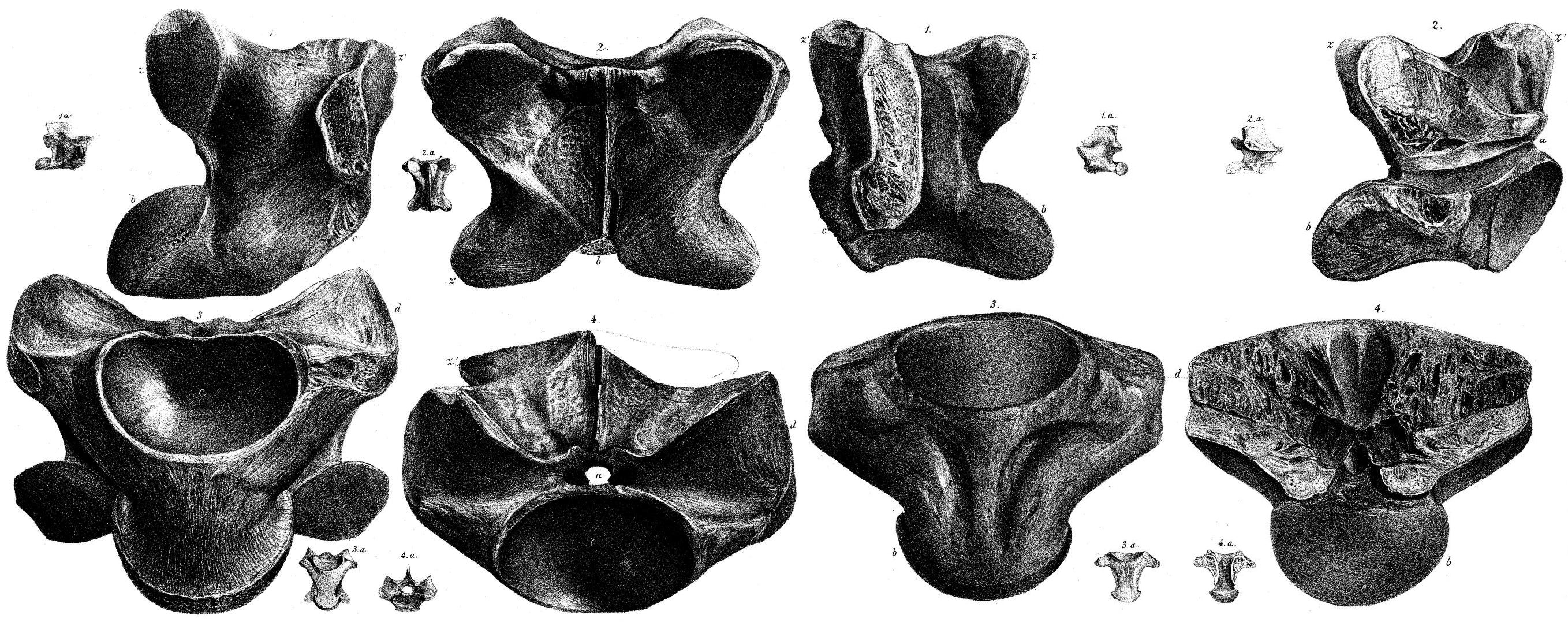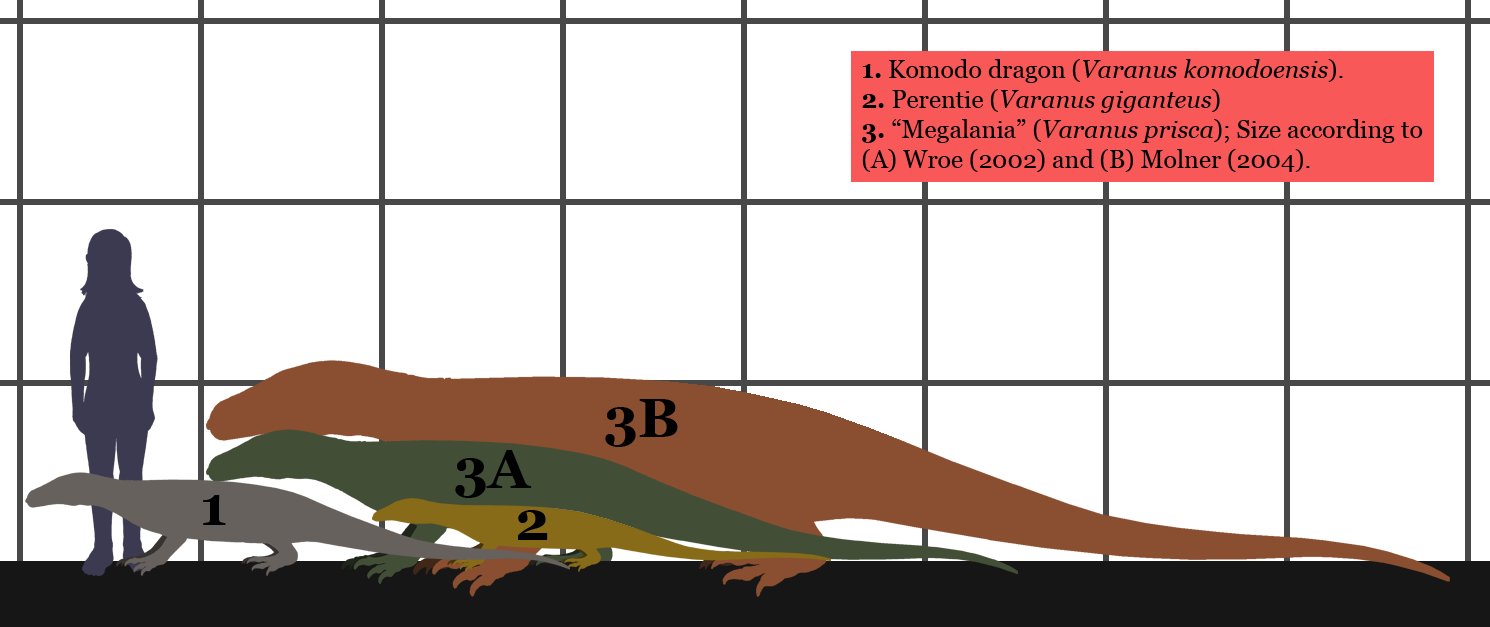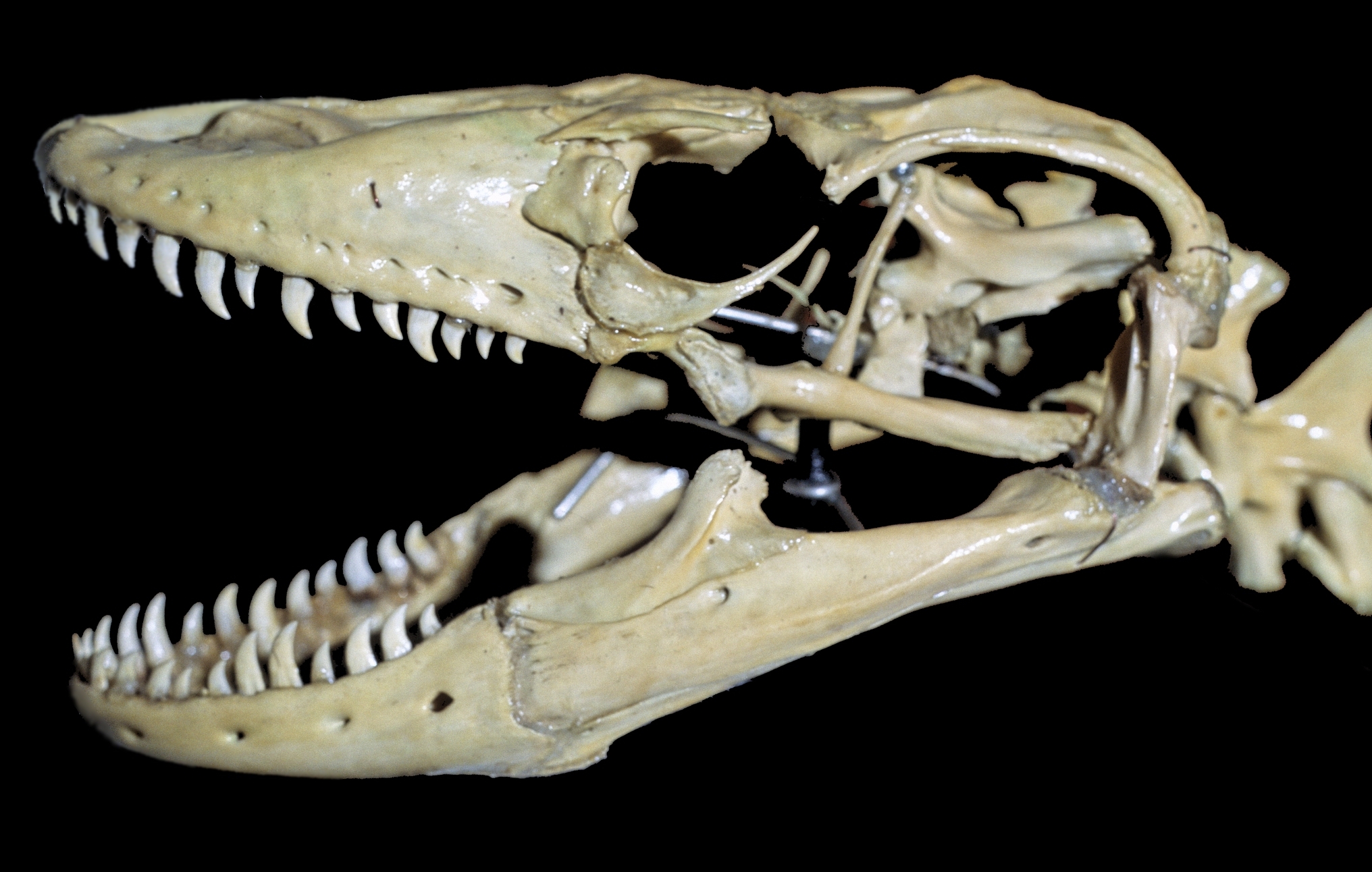|
Megalania
Megalania (''Varanus priscus'') is an extinct species of giant monitor lizard, part of the megafaunal assemblage that inhabited Australia during the Pleistocene. It is the largest terrestrial lizard known to have existed, reaching an estimated length of 3.5 to 7 metres (11.5 – 23 ft), and weighing between , but the fragmentary nature of known remains make estimates highly uncertain. Megalania is thought to have had a similar ecology to the living Komodo dragon (''Varanus komodoensis''). The youngest fossil remains of giant monitor lizards in Australia date to around 50,000 years ago. The first indigenous settlers of Australia might have encountered megalania, and been a factor in megalania's extinction. While originally megalania was considered to be the only member of the titular genus "''Megalania''", today it is considered a member of the genus ''Varanus'', being closely related to other Australian monitor lizards. Taxonomy Sir Richard Owen described the first known ... [...More Info...] [...Related Items...] OR: [Wikipedia] [Google] [Baidu] |
Megalania
Megalania (''Varanus priscus'') is an extinct species of giant monitor lizard, part of the megafaunal assemblage that inhabited Australia during the Pleistocene. It is the largest terrestrial lizard known to have existed, reaching an estimated length of 3.5 to 7 metres (11.5 – 23 ft), and weighing between , but the fragmentary nature of known remains make estimates highly uncertain. Megalania is thought to have had a similar ecology to the living Komodo dragon (''Varanus komodoensis''). The youngest fossil remains of giant monitor lizards in Australia date to around 50,000 years ago. The first indigenous settlers of Australia might have encountered megalania, and been a factor in megalania's extinction. While originally megalania was considered to be the only member of the titular genus "''Megalania''", today it is considered a member of the genus ''Varanus'', being closely related to other Australian monitor lizards. Taxonomy Sir Richard Owen described the first known ... [...More Info...] [...Related Items...] OR: [Wikipedia] [Google] [Baidu] |
Varanus Priscus
Megalania (''Varanus priscus'') is an extinct species of giant monitor lizard, part of the megafaunal assemblage that inhabited Australia during the Pleistocene. It is the largest terrestrial lizard known to have existed, reaching an estimated length of 3.5 to 7 metres (11.5 – 23 ft), and weighing between , but the fragmentary nature of known remains make estimates highly uncertain. Megalania is thought to have had a similar ecology to the living Komodo dragon (''Varanus komodoensis''). The youngest fossil remains of giant monitor lizards in Australia date to around 50,000 years ago. The first indigenous settlers of Australia might have encountered megalania, and been a factor in megalania's extinction. While originally megalania was considered to be the only member of the titular genus "''Megalania''", today it is considered a member of the genus ''Varanus'', being closely related to other Australian monitor lizards. Taxonomy Sir Richard Owen described the first known ... [...More Info...] [...Related Items...] OR: [Wikipedia] [Google] [Baidu] |
Komodo Dragon
The Komodo dragon (''Varanus komodoensis''), also known as the Komodo monitor, is a member of the monitor lizard family Varanidae that is endemic to the Indonesian islands of Komodo, Rinca, Flores, and Gili Motang. It is the largest extant species of lizard, growing to a maximum length of , and weighing up to . As a result of their size, Komodo dragons are apex predators, and dominate the ecosystems in which they live. Komodo dragons hunt and ambush prey including invertebrates, birds, and mammals. It has been claimed that they have a venomous bite; there are two glands in the lower jaw that secrete several toxic proteins. The biological significance of these proteins is disputed, but the glands have been shown to secrete an anticoagulant. Komodo dragons' group behavior in hunting is exceptional in the reptile world. The diet of Komodo dragons mainly consists of Javan rusa (''Rusa timorensis''), though they also eat considerable amounts of carrion. Komodo dragons also occ ... [...More Info...] [...Related Items...] OR: [Wikipedia] [Google] [Baidu] |
Australian Megafauna
The term Australian megafauna refers to the megafauna in Australia during the Pleistocene Epoch. Most of these species became extinct during the latter half of the Pleistocene, and the roles of human and climatic factors in their extinction are contested. There are similarities between the prehistoric Australian megafauna and some mythical creatures from the Aboriginal Dreamtime. Causes of extinction Many modern researchers, including Tim Flannery, think that with the arrival of early Aboriginal Australians (around 70,000~65,000 years ago), hunting and the use of fire to manage their environment may have contributed to the extinction of the megafauna. Increased aridity during peak glaciation (about 18,000 years ago) may have also contributed, but most of the megafauna were already extinct by this time. Others, including Steve Wroe, note that records in the Australian Pleistocene are rare, and there is not enough data to definitively determine the time of extinction of many o ... [...More Info...] [...Related Items...] OR: [Wikipedia] [Google] [Baidu] |
Quinkana
''Quinkana'' is an extinct genus of mekosuchine crocodylians that lived in Australia from about 28 million to about 10,000 years ago. Most attributed specimens have been found in Queensland. It is speculated to have been one of the top predators of Pleistocene Australia, along with megalania, the giant monitor lizard, and the modern saltwater crocodile. The genus and type species, ''Q. fortirostrum'' was named by paleontologist Ralph E. Molnar in 1981. Other species in the genus are ''Q. timara'' (1994), ''Q. babarra'' (1996), and ''Q. meboldi'' (1997). The name ''Quinkana'' comes from the "Quinkans", a legendary folk spirit from Gugu-Yalanji mythology. ''Quinkana'' is thought to possess long legs and had ziphodont teeth (lateromedially compressed, recurved, and serrated). The genus is distinguishable by the combination of these ziphodont teeth and a broad snout. It also has a unique alveolar (tooth socket) structure and a short anterior palatine process (upper mouth bone). ''Q ... [...More Info...] [...Related Items...] OR: [Wikipedia] [Google] [Baidu] |
Marsupial Lion
''Thylacoleo'' ("pouch lion") is an extinct genus of carnivorous marsupials that lived in Australia from the late Pliocene to the late Pleistocene (2 million to 46 thousand years ago). Some of these marsupial lions were the largest mammalian predators in Australia of their time, with ''Thylacoleo carnifex'' approaching the weight of a lioness. The estimated average weight for the species ranges from . Taxonomy The genus was first published in 1859, erected to describe the type species ''Thylacoleo carnifex''. The new taxon was established in examination of fossil specimens provided to Richard Owen. The familial alliance takes its name from this description, the so-called marsupial lions of Thylacoleonidae. The colloquial name "marsupial lion" alludes to the superficial resemblance to the placental lion and its ecological niche as a large predator. ''Thylacoleo'' is not closely related to the modern lion (''Panthera leo''). Genus: ''Thylacoleo'' (''Thylacopardus'') – Australia' ... [...More Info...] [...Related Items...] OR: [Wikipedia] [Google] [Baidu] |
Monitor Lizard
Monitor lizards are lizards in the genus ''Varanus,'' the only extant genus in the family Varanidae. They are native to Africa, Asia, and Oceania, and one species is also found in the Americas as an invasive species. About 80 species are recognized. Monitor lizards have long necks, powerful tails and claws, and well-developed limbs. The adult length of extant species ranges from in some species, to over in the case of the Komodo dragon, though the extinct varanid known as megalania (''Varanus priscus'') may have been capable of reaching lengths more than . Most monitor species are terrestrial, but arboreal and semiaquatic monitors are also known. While most monitor lizards are carnivorous, eating eggs, smaller reptiles, fish, birds, insects, and small mammals, some also eat fruit and vegetation, depending on where they live. Distribution The various species cover a vast area, occurring through Africa, the Indian subcontinent, to China, the Ryukyu Islands in southern Japan, s ... [...More Info...] [...Related Items...] OR: [Wikipedia] [Google] [Baidu] |
Pleistocene
The Pleistocene ( , often referred to as the ''Ice age'') is the geological Epoch (geology), epoch that lasted from about 2,580,000 to 11,700 years ago, spanning the Earth's most recent period of repeated glaciations. Before a change was finally confirmed in 2009 by the International Union of Geological Sciences, the cutoff of the Pleistocene and the preceding Pliocene was regarded as being 1.806 million years Before Present (BP). Publications from earlier years may use either definition of the period. The end of the Pleistocene corresponds with the end of the last glacial period and also with the end of the Paleolithic age used in archaeology. The name is a combination of Ancient Greek grc, label=none, πλεῖστος, pleīstos, most and grc, label=none, καινός, kainós (latinized as ), 'new'. At the end of the preceding Pliocene, the previously isolated North and South American continents were joined by the Isthmus of Panama, causing Great American Interchang ... [...More Info...] [...Related Items...] OR: [Wikipedia] [Google] [Baidu] |
Melbourne Museum
The Melbourne Museum is a natural and cultural history museum located in the Carlton Gardens, Melbourne, Carlton Gardens in Melbourne, Australia. Located adjacent to the Royal Exhibition Building, the museum was opened in 2000 as a project of the Government of Victoria, on behalf of Museums Victoria which administers the venue. The museum won Best Tourist Attraction at the Australian Tourism Awards in 2011. In addition to its galleries, the museum features spaces such as ''Curious?'', which is a place to meet staff and find answers relating to the collections, research, and behind-the-scenes work of Museums Victoria; as well as a cafe and a gift shop. The back-of-house area houses some of the Victoria's State Collections, which holds over 17 million items, including objects relating to Indigenous Australian and Pacific Islander cultures, geology, historical studies, palaeontology, technology and society, and zoology, as well as a library collection that holds 18th and 19th cent ... [...More Info...] [...Related Items...] OR: [Wikipedia] [Google] [Baidu] |
Argus Monitor
The yellow-spotted monitor (''Varanus panoptes''), also known as the Argus monitor, is a monitor lizard found in northern and western regions of Australia and southern New Guinea. Taxonomy The first description of the species was provided in a revision of the varanids of Western Australia, where the family is represented by diverse taxa in a wide variety of habitats. Early collections and descriptions of the region's species have historically been uncertain, leading the ICZN to issue an opinion that related to this taxon. A third subspecies was published in 1988, based on specimens from southern New Guinea. The describing author discovered that the specimen selected as the type of '' Varanus gouldii'' was in fact assignable to this species, recently described by reptile specialist Glenn Storr. By issuing an opinion on the various taxonomic considerations, the voting members conserved the name published with John Edward Gray's description and stabilised the nomenclature of this sp ... [...More Info...] [...Related Items...] OR: [Wikipedia] [Google] [Baidu] |
Extant Monitor Lizards-Megalania SIZE
{{disambig ...
Extant is the opposite of the word extinct. It may refer to: * Extant hereditary titles * Extant literature, surviving literature, such as ''Beowulf'', the oldest extant manuscript written in English * Extant taxon, a taxon which is not extinct, such as an extant species * Extant Theatre Company, a disability arts organisation * ''Extant'' (TV series), an American television series * Hank Hall, also known as Extant, a DC Comics supervillain See also * Extent (other) Extent may refer to: Computing * Extent (file systems), a contiguous region of computer storage medium reserved for a file * Extent File System, a discontinued file system implementation named after the contiguous region * Extent, a chunk of st ... [...More Info...] [...Related Items...] OR: [Wikipedia] [Google] [Baidu] |
Apex Predator
An apex predator, also known as a top predator, is a predator at the top of a food chain, without natural predators of its own. Apex predators are usually defined in terms of trophic dynamics, meaning that they occupy the highest trophic levels. Food chains are often far shorter on land, usually limited to being secondary consumers – for example, wolves prey mostly upon large herbivores (primary consumers), which eat plants (primary producers). The apex predator concept is applied in wildlife management, conservation, and ecotourism. Apex predators have a long evolutionary history, dating at least to the Cambrian period when animals such as ''Anomalocaris'' dominated the seas. Humans have for many centuries interacted with apex predators including the wolf, birds of prey, and cormorants to hunt game animals, birds, and fish respectively. More recently, humans have started interacting with apex predators in new ways. These include interactions via ecotourism, such as with ... [...More Info...] [...Related Items...] OR: [Wikipedia] [Google] [Baidu] |





.jpg)


_2.jpg)
